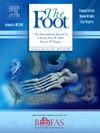插入性跟腱病:与较短的自由肌腱的新联系
Q2 Health Professions
引用次数: 0
摘要
背景:跟腱病是运动员中常见的过度使用损伤,分为中部型和插入型。虽然现有文献主要强调中部肌腱病变是更普遍的形式,但新出现的证据强调了插入性肌腱病变的重要性。临床表现的差异需要进一步调查,特别是解剖差异可以为治疗策略和康复方案提供信息。目的本研究旨在评估跟腱病变的患病率,并探讨插入型和中位型跟腱病变游离肌腱长度的解剖学差异。研究设计本研究是一项横断面分析,是对跟腱病患者力学特性进行的大型纵向研究的一部分。MethodsA共有103名患者(38.8 %雄性,61.2 %女性,年龄:53 ± 12.8年,身体质量指数(BMI): 30 ±7.4 kg / m2, 60 %久坐而40 %活跃)诊断为跟腱病态来自马耳他群岛的人被招募为超声评估肌腱长度测量和评估相关的解剖特征。参与者根据肌腱病变的类型进行分类。结果插入肌腱病变的患病率(67.9% %)高于中间部分肌腱病变(20.3% %)。值得注意的是,参与者与插入病变呈现短肌腱( 3.8±1.4 厘米,p = & lt; 0.001)相比自由肌腱长度较长的明显病变( 5.9±1.3 厘米,p = & lt; 0.001)。这种解剖学上的差异,以及比目鱼肌的下附著,可能导致不同的生物力学特性,影响特定肌腱病变的风险。结论:本研究首次报道了插入性肌腱病变的较高患病率,并强调了游离肌腱长度短与插入性肌腱病变之间的联系。这强调了监测短游离肌腱的重要性,因为它们可能是插入性肌腱病发展的关键。本文章由计算机程序翻译,如有差异,请以英文原文为准。
Insertional Achilles tendinopathy: A novel link to shorter free tendons
Background
Achilles tendinopathy is a common overuse injury among athletes, classified into mid-portion and insertional types. While existing literature primarily emphasizes mid-portion tendinopathy as the more prevalent form, emerging evidence highlights the significance of insertional tendinopathy. Variations in clinical presentation warrant further investigation, particularly regarding anatomical differences that could inform treatment strategies and rehabilitation protocols.
Purpose
This study aimed to assess the prevalence of Achilles tendon pathologies and explore anatomical differences in the length of the free tendon between insertional and mid-portion tendinopathy.
Study design
This study represents a cross-sectional analysis conducted as part of a larger longitudinal study on the mechanical properties of patients with Achilles tendinopathy.
Methods
A total of 103 patients (38.8 % males, 61.2 % females, age: 53 ± 12.8 years, body Mass Index (BMI): 30 ± 7.4 kg/m2, 60 % sedentary while 40 % active) diagnosed with Achilles tendon pathologies from across the Maltese islands were recruited for ultrasound assessments to measure tendon length and evaluate associated anatomical characteristics. Participants were categorised based on the type of tendinopathy.
Results
A higher prevalence of insertional tendinopathy (67.9 %) was identified compared to mid-portion tendinopathy (20.3 %). Notably, participants with insertional tendinopathy presented with short tendons (3.8 ± 1.4 cm, p = <0.001) compared to those with longer free tendon length in mid-portion tendinopathy (5.9 ± 1.3 cm, p = <0.001). This anatomical distinction, along with the lower attachment of the soleus muscle, may contribute to differing biomechanical properties, influencing the risk of specific tendon pathologies.
Conclusions
This study is the first to report a higher prevalence of insertional tendinopathy and to highlight the link between short free tendon length and insertional tendinopathy. This emphasizes the importance of monitoring short free tendons, as they are likely pivotal in the development of insertional tendinopathy.
求助全文
通过发布文献求助,成功后即可免费获取论文全文。
去求助
来源期刊

Foot
Health Professions-Podiatry
CiteScore
2.00
自引率
0.00%
发文量
37
期刊介绍:
The Foot is an international peer-reviewed journal covering all aspects of scientific approaches and medical and surgical treatment of the foot. The Foot aims to provide a multidisciplinary platform for all specialties involved in treating disorders of the foot. At present it is the only journal which provides this inter-disciplinary opportunity. Primary research papers cover a wide range of disorders of the foot and their treatment, including diabetes, vascular disease, neurological, dermatological and infectious conditions, sports injuries, biomechanics, bioengineering, orthoses and prostheses.
 求助内容:
求助内容: 应助结果提醒方式:
应助结果提醒方式:


